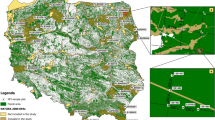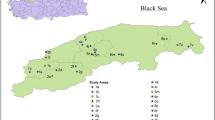Abstract
THE literature dealing with the wood-boring bivalve, Teredo, is extensive. The majority of investigations, however, have dealt with floating structures and little attention has been paid to the problem of vertical distribution. During a recent investigation into an attack of T. norvegica on wooden structures at Loch Ryan, Scotland, information was obtained regarding the vertical distribution of this species.
This is a preview of subscription content, access via your institution
Access options
Subscribe to this journal
Receive 51 print issues and online access
$199.00 per year
only $3.90 per issue
Buy this article
- Purchase on Springer Link
- Instant access to full article PDF
Prices may be subject to local taxes which are calculated during checkout
Similar content being viewed by others
References
Doochin, H., and Smith, F. G. W., Bull. Mar. Sci. Gulf and Caribbean, 1, 196 (1951).
Isham, L. B., Smith, F. G. W., and Springer, V., Bull. Mar. Sci. Gulf and Caribbean, 1, 46 (1951).
Author information
Authors and Affiliations
Rights and permissions
About this article
Cite this article
OWEN, G. Vertical Distribution of Teredo norvegica. Nature 171, 484–485 (1953). https://doi.org/10.1038/171484a0
Issue Date:
DOI: https://doi.org/10.1038/171484a0
This article is cited by
-
Late stage bivalve larvae in a well-mixed estuary are not inert particles
Estuaries (2003)
-
Distribution and abundance of marine wood borers on the west coast of Peninsular Malaysia
Hydrobiologia (1994)
-
Vertical distribution of marine wood boring animals in Cochin Harbour, south west coast of India
Hydrobiologia (1966)
Comments
By submitting a comment you agree to abide by our Terms and Community Guidelines. If you find something abusive or that does not comply with our terms or guidelines please flag it as inappropriate.



